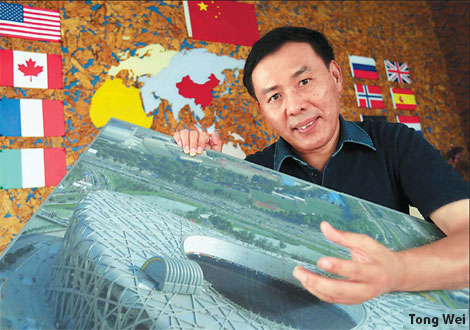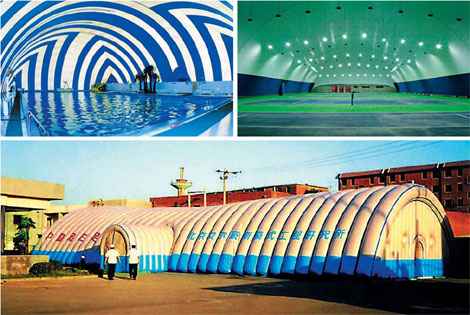


Tong Wei describes his career as "blowing" - making something filled with air - or "chui" in Chinese, meaning "boast" or "brag". It has basis in fact.
He got his start manufacturing inflatable toys and structures, but Tong's no braggart. As a matter of fact, he's a down-to-earth, scholarly soul who puts research and development at the center of his business, the Beijing Airhouse Membranous Engineering Research Institute.
As general manager of the air and tensile membrane structure company, Tong is usually busy traveling around the lab, workshop and building sites in blue work clothes and seems more like several employees, sometimes a researcher, an engineer or a technician.
"To the membranous structure sector, the first-hand information is the foundation of lab work," the 53-year-old Beijinger tells China Business Weekly.
Membranous structure engineering includes three structure forms, air-supported and air-tube, rigid framed and tensile-stress.
The most well-known membranous structure building in China is the Water Cube - the National Swimming Stadium for the Beijing 2008 Olympic Games, designed by a consortium made up of PTW Architects (an Australian architecture firm), Arup international engineering group, CSCEC (China State Construction Engineering Corporation), and CCDI (China Construction Design International) of Shanghai.
The new construction concept was developed in the West in 1950s, while until the mid 1990s, there were few related structures in China where Tong is a pioneer in the industry. But his start began with large inflatable toys.
Majoring in steel structure engineering, Tong got his first job in a steel machines and engineering factory affiliated to Beijing No 1 Commerce Bureau in 1974. Under the planned economy, the factory's orders came from the bureau's plans instead of contracts from the marketplace. Though no one suffered from competitive stress, in the 1990s Tong quit his secure job to strike out on his own.
After careful market investigation, Tong decided to devote himself to membranous product engineering development, a virgin field in the Chinese market at the time. His long experience in plate work and mechanical engineering was his only capital then.
Inflatable business
As the largest shareholder, Tong, with other four partners, registered a shareholding company, named Beijing Airhouse Engineering Company in 1991 and kicked off their business with Beijing Children's City, a series of inflatable cartoon characters, toys and miniature buildings. Beijing Children's City became a regular part of International Children's Day (June 1) and summer vacations in Beijing.
The turnover from Beijing Children's City for the first session was over 10,000 yuan per day. It was a great success in business, compared with the average salary 100 yuan per month of Beijing dwellers in the early 1990s.
Beijing Children's City was subsequently established as a brand for children's entertainment in the 1990s. In addition to the right market position, its success also depended on new product development. There are 15 to 20 new inflatable entertainment facilities being designed and listed under the brand every year, catering to kids' interest in novelty. And to date the company has produced more than 1,000 large air toys.
In 1992, a domestic company Beijing Golden Spider Software Company contacted Beijing Airhouse, offering 120,000 yuan for sponsorship of Beijing Children's City for advertising their company on a huge inflatable spider. The air-supported "spider" covers half of a standard soccer court, with an inner height of 10 meters so that a big truck can run through it.
"It was really a hard nut for us to crack designing irregular airhouse shapes without CAD ( Computer Aided Design) at that time," recalls Tong, who used a steel structure model and tested it on-site many times to make the giant spider stand securely. There was no example for us to follow then. We just started from plate work layout and tried our best to find our own way."
The giant inflatable "spider" attracted the attention of a professor from Tsinghua University, who had just returned to China and had been involved in membranous structure research abroad. The professor pointed out that an air-supported structure is rather a kind of membranous structure architecture.
"It was the first time that I'd heard the concept, which inspired me to research other materials and found few people had tapped this field in China," says Tong. He turned his company's name from Beijing Airhouse Engineering Company to Beijing Airhouse Membranous Engineering Research Institute and decided to carry out research into emerging tensile membrane technology and apply it once he had enough money. It wasn't until 1996 that Beijing Tsinghua University and Shanghai Tongji University established a major in membrane structure engineering.
Bright future
"I believed it (membranous structure) would have a promising future, in the sense of ever-increasing demands for cost-effective operation and energy saving, materials recycling and architectural innovation," Tong says.
Compared with traditional building technologies, tensile membranous has some advantages, such as a better cost-to-performance ratio with less construction time, much less construction waste, energy savings due to the excellent heat isolation and the transparency of the special membrane.
From 1991-1998, Tong accumulated millions of yuan thanks to its Children's City business and large-sized inflatable toys exported to North America, Australia, Spain, Portugal and the Middle East.
One of the milestones of the company were models for the Kunming World Horticulture Fair 1999 of Beijing's Temple Of Heaven, the Sydney Opera House, the Sphinx and the Arc de Triomphe, each as high as 10 meters.
Tong declines to say how much money and time he spent on the project, but he stressed that the company benefited from its engineering research and the subsequent success. They made Airhouse the leader both in tech-research and marketing in the field.
The orders flowed in after the Kunming fair, including four floats for the celebration parade of the 50th anniversary of the People's Republic of China, a full size replica of a Boeing 747 the National Spring Festival Gala Evening in 2000, a tennis stadium and a badminton stadium in Beijing.
In the 21st century, Airhouse's performance has progressed steadily, with a sales revenue growth rate standing at 10 percent. The revenue amounted to 70 million yuan last year.
Now, the longest life time of a membranous structure building can span more than 50 years.
Such buildings are especially suitable for sports, commerce, exhibition and conventions, as well as transportation services. "The market is really promising," says Tong.
He also acknowledges that the competition has intensified, with foreign counterparts such as German C+M, Japanese Taiyo Kogyo and US-based Birdair and domestic competitors Beijing New Lyman, Tianjin Kangda and Shanghai Hanjieyi.
But the tech-sensitive entrepreneur says continued innovation is the way to maintain a leading position in the market.
More than 20 professionals among the 300 Airhouse employees are devoted to research and development from membranous structure design and engineering to new materials application.
"One of the weak points of the membranous structure is that the membrane is easily split and scratched. We are now focusing on scratch -proof and split-proof membrane development and expect to have some engineering applications in the near future," Tong says.
He adds that Airhouse has paid close attention to some membranous technology development for military use, especially in the United States, and will try to adopt some of it for civilian use when it's possible.
"Technology is always our priority, which has us leading the market instead of following."

(China Daily 10/13/2008 page12)













